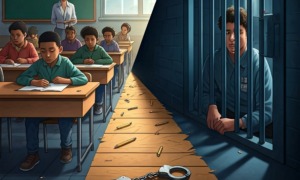“Let me tell you something, honey. You’re a big queen yourself and you need to come out of the closet.”
A fine welcome this was: Gary Mallon’s third day as director of an independent living program, and one of the teens calls him a homosexual. Mallon laughed and said, “All you gay people think everybody’s gay.”
But the kid was right.
Mallon was a married 30-year-old youth worker who had vowed to revamp New York City’s Gramercy Residence for foster kids, run by Green Chimneys Children’s Services. That turned out to be easy compared to what happened in the process: spurred by the kids at Gramercy, Mallon drastically changed his own life, and set out to shake up the delivery of services to homosexual foster youth throughout the nation.
Mallon has become arguably the most prominent gay youth worker in the country. He has literally written the book on serving gay foster youth, has changed how New York City handles gay kids in its care, and has influenced thousands of youth workers and bureaucrats through his writings and through teachings – at college, at Child Welfare League of America conferences, and at agencies like Southern Christian Services for Children, Youth and Families, in Jackson, Miss.
“He’s had the impact. It was Gary who stimulated people into addressing concerns about gay and lesbian youngsters in foster care,” says Alan Siskind, president of the Jewish Board of Family and Children’s Services in New York.
“This was an issue that 10 years ago people were not talking about, and 10 years later they are,” says New York City school board member Doug Robinson, former co-chair of Center Kids, a family project for the Gay and Lesbian Community Service Center. He credits Mallon for the change.
That’s a big impact for a man who says that as a kid, “I really wanted to be a veterinarian.”
Convent Life
Gerald P. “Gary” Mallon, 43, grew up in the Bronx and nearby Rockland County with two brothers, a sister, a mother who stayed home to raise them and a father who worked as an A&P supermarket dairy manager. (Surprise: one of Mallon’s first jobs as a youth was in an A&P.) He loved animals, but his career dreams were dashed in high school when he realized, “I was not great at science.”
That was okay, because Mallon had become active in the Catholic Youth Organization (CYO) at St. Catharine’s Parish in Blauvelt, N.Y. The CYO focused on social justice work: visiting patients in psychiatric hospitals, painting elderly people’s homes and organizing food drives. Mallon recalls thinking, “‘My God, people get paid to do this. What fun!’ I liked working with people more than I liked working with animals.”
Mallon eventually served as the New York Archdiocese CYO president. “The adults gave us big responsibilities” for organizing and administering their work, Mallon says. “They really treated us like adults, not like kids. … What these people did was youth development. They gave me a skill that I took and used my whole life.”
Although he’s carved a unique niche, Mallon’s career path is familiar to anyone in youth work: it is a path of sudden and frightening opportunities, as he was repeatedly handed responsibilities for kids with little to go on but instinct, whatever he could apply from class work, and on-the-job-training. “There were a lot of times I didn’t know what the hell I was doing,” he says. “But I acted like I knew what I was doing. And I had great supervisors.”
It began when he won a scholarship for his CYO work to Dominican College at Blauvelt. While pursuing his social work degree, he talked his way into a job at a nearby orphanage, St. Dominic’s Home. At 18, he was overseeing a dorm of 15 boys, ages 6 to 13, responsible for everything from meals, laundry and showers to recreation and participating in treatment teams. “I learned a lot about managing kids. A lot more about controlling them than caring about them,” he says. “Sr. Caroline upstairs would get upset if she heard any noise from my unit.”
Nuns, in fact, played a key role in his professional growth. From St. Dominic’s he moved to St. Agatha’s Home for retarded boys and girls, ages eight to 20. He was 20 himself when he became a supervisor, and enjoyed it more than the orphanage because the programs were “more creative” and “the nuns were much cooler.” A year later he moved into an old convent – the home of Grace House, a CYO-operated non-residential youth center that included a free apartment for the new director. “I had the mother superior’s [former] apartment,” Mallon says. “It was gorgeous, two big bedrooms.”
A youth worker living large in Manhattan? “It was very exciting, but very scary,” Mallon says. He was the only paid staffer, relying on volunteers to run afternoon and weekend programs such as leadership development for foster kids, retreats for parents and youth, and various activities for mentally retarded youth – totaling 18,000 visits by kids each year.
While there, Mallon got married. He had met the woman through CYO, and says he was in love. “I knew I was gay since I was very young,” he says. “I thought being gay was about having sex, not about having a relationship, and certainly not about having a partner.”
That illusion lasted for several years – until he visited Gramercy in 1987.
‘We’re Safe Here’
By then Mallon was 30, had an MSW, and was director of residential programs at Abbot House, a large residential child welfare agency that works under city contract. One day he and a co-worker set out to visit independent living (IL) programs in Manhattan, including the Gramercy Residence for adolescent boys, a four-story rowhouse on the East Side.
“There was no program,” Mallon recalls. “Kids were doing whatever they wanted. I said to the staff, ‘How many kids are here?’ They said, ‘I don’t know.’ … I said, “Who is your director?’ They said, ‘We don’t have one.'” Gramercy, a staffer explained, “was going through some changes.”
Mallon wrote to Sam Ross, founder and executive director of the parent agency, Green Chimneys, a nonprofit based in Brewster, N.Y., which had been running residential treatment, life skills training and other youth services since 1948. The message: you have a facility with no program; if you want to create one, call. “It was very ballsy thing to do,” Mallon says.
“I like that, that somebody is not afraid to speak his mind,” Ross says. He called. Green Chimneys soon offered Mallon the challenge he asked for, and was somewhat surprised when he took it. The new job came with a $2,000 pay cut.
On his third day, four boys marched in to see the new director. “Yes, we are gay,” one said, “and don’t you go trying to change that.”
“I have no intention of changing that,” a shocked Mallon replied. He wondered why they felt the need to tell him this. “We’ve been in a lot of other places,” one youth said. “The reason we’re safe here is that there’s more than one of us.”
As a parting gesture, one of them dropped the “you’re a queen” bomb on Mallon. That, along with the subsequent death of his father in 1988, ignited a soul-searching. “Here they are, 16, 17, 18, living proudly, being themselves, really taking a lot of shit from people. I thought, ‘Wow, these kids are brave. … I’m 30 and I’m still not out of the closet.
“This is youth development in reverse, I guess.”
Mallon eventually confided his feelings to his wife. “I really need to deal with this thing,” he told her.
He told Ross, too. Ross said he didn’t care about Mallon’s sexuality. But as a man in charge of a residential program for males, Mallon felt obliged to stress that “being gay doesn’t mean I’m interested in sleeping with boys.”
While Mallon’s work with youth stems from a social justice passion dating to his teen CYO days, confronting his personal conflict changed his professional path. Had he continued living a straight man’s life, he says, he would not have become such a powerful advocate for gay youth.
The Soapbox
He had known something about the struggles that homosexuals face in residential programs, and the kids at Gramercy brought those struggles to vivid life. They told of living in facilities where the youth workers had no clue about how to help them deal with their sexuality, being booted out by homophobic foster parents, and being teased and beaten by straight kids in the homes. For some, the streets were safer.
Those who landed at Gramercy felt at ease. This was something of an accident, borne of the agency’s culture of tolerance. “I guess we’re an accepting agency,” says Ross, the Green Chimneys founder. “I’ve dealt with gay people, we have friends who are gay.”
Ross liked Mallon’s work and gave him considerable leeway. Mallon put out word among the city’s child protection workers that more gay teens were welcome. Gramercy’s 25 slots were soon filled with gay, lesbian, bisexual, transgender and questioning (or “GLBTQ”) youth. (The city’s Administration for Children’s Services now pays Gramercy $195 a day for each bed filled.) But they couldn’t all fit into Gramercy, so Mallon began conducting training workshops on how to serve gay youth, first for city social workers, then at CWLA and other professional conferences.
How ready was the youth field to talk about homosexual youth? In 1991 Mallon stood at a podium in St. Louis as the keynote speaker at a conference of the American Association of Children’s Residential Centers. He spoke about the needs of gay kids in residential facilities, then waited for questions; conference keynoters always get questions. There were none for Mallon – until, after a period of awkward silence, a gay man stepped forward to ask something. Mallon’s subsequent workshop on serving gay youth was attended by “two lesbians and a gay man.” On the conference bus, he sat alone.
“You’d think we [the youth work field] would be more up to speed” in confronting the issue, says CWLA Youth Services Director Robin Nixon, who met Mallon when she ran Residential Youth Services, an independent living program in Virginia, in the early ’90s. But, says Nixon, the profession shared society’s unease with the subject. It’s not that no one tried: in the 1970s and 80s there was a smattering of papers and presentations about gay youth in residential care. In 1984, youth worker and gay activist Terry DeCrescenzo launched Gay and Lesbian Adolescent Social Services (GLASS), a residential facility in West Hollywood. In 1991 CWLA held a colloquium on “Serving Gay & Lesbian Youths.”
But no one was speaking consistently enough or from a big enough soapbox to have a significant impact. Mallon was in a unique position: he was an accomplished youth worker, he had academic credentials (Ph.D., social welfare), and he was openly gay. He also speaks his mind. “He can become a little hot-headed,” says Joseph Whalen, who became executive director of Green Chimneys when Ross retired in 1998. “Anybody who’s a leader has got to ruffle some feathers.”
Impact
Mallon has ruffled flocks. He has berated city bureaucrats for ignoring the special needs of gays in foster care, and has been a constant (and sometimes thorny) presence at the offices of the city’s Administration for Children’s Services (ACS), serving on several advisory panels. “He was the single crusader for gay youth in New York City,” says Lynn Echenberg, who served an assistant to reform-minded ACS administrator Nicholas Scoppetta. “He was trying to push the administration to pay attention to gay youth. … He does it with such skill, dexterity and diplomacy – okay, maybe not diplomacy.”
His influence has extended well beyond that agency and his city. Aside from training hundreds of ACS staff in how to serve gay youth (Green Chimneys now has a contract to conduct that training), Mallon has trained countless youth workers at private agencies and at conferences (such as CWLA conferences) throughout the country. As a professor at New York’s Hunter College, Mallon has taught hundreds of students, thus influencing how countless new social workers deal with gay youth.
“What Gary did for me was light a fire under me,” says Marcia Sideris, a former caterer who is getting her MSW at age 55. After three courses with Mallon, she decided to focus her work on GLBTQ youth, and now works at Green Chimneys.
Can’t get to a Mallon class? Just read: his theories on serving gay youth have appeared in numerous journals (such as Residential Treatment for Children & Youth and various CWLA publications). In 1998 he published, “We Don’t Exactly Get the Welcome Wagon: The Experience of Gay and Lesbian Adolescents in Child Welfare Systems,” and has published several books since.
When he gives workshops now, “60 or 70 people will come. And while he appreciates being called “the expert” in serving GLBTQ youth, it gets lonely. “I always hoped some other colleagues would join me” in the cause, he says.
The goal, says Mallon, is to give foster and homeless gay youth safe places to focus on their sexuality and other issues, so they can prepare to live in a straight world. Green Chimneys does that through counseling and other services specifically for gay youth at Gramercy (where most of the staff is GLBTQ), housing a city-run school for the residents on site, and setting up youth in transitional apartments around the city. (Mallon now helps run Green Chimney’s GLBTQ youth programs in the city as a consultant while he teaches at Hunter.)
Mallon’s personal life has settled as well. He lives with a partner and is stepfather to the man’s two children. And he gets to care for animals: they have two dogs and a cat.































